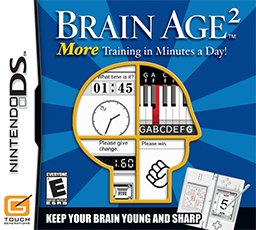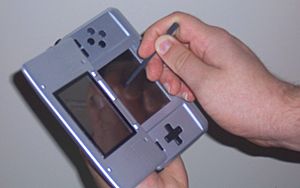Brain Age 2: More Training in Minutes a Day! facts for kids
Quick facts for kids Brain Age 2:More Training in Minutes a Day! |
|
|---|---|

North American box art
|
|
| Developer(s) | Nintendo SPD |
| Publisher(s) | Nintendo |
| Director(s) | Kouichi Kawamoto |
| Producer(s) | Shinya Takahashi |
| Composer(s) | Minako Hamano |
| Series | Brain Age |
| Platform(s) | Nintendo DS |
| Release date(s) |
|
| Genre(s) | Puzzle, edutainment |
| Mode(s) | Single-player, multiplayer |
Brain Age 2: More Training in Minutes a Day! (stylized as Brain Age2), known as More Brain Training from Dr Kawashima: How Old Is Your Brain? in PAL regions, is an edutainment puzzle game and the sequel to Brain Age: Train Your Brain in Minutes a Day! (2005). It was developed and published by Nintendo for the Nintendo DS handheld game console. Before the game begins, the player must perform a Brain Age Check to determine their brain age, which ranges from 20 to 80, to determine approximately their brain's responsiveness. A brain age of 20, the lowest age that the player can achieve, indicates that the player's brain is as responsive as that of an average 20-year-old. After the player is told their initial brain age, they can complete a series of minigames to help improve their brain's responsiveness, after which they can run Brain Age Check again to determine their updated brain age.
Critics were generally favorable towards Brain Age 2, which received aggregated scores of 77% from Metacritic and 79.04% from GameRankings. Praise focused on improvements made on Brain Age, while criticism targeted the game's inability to consistently understand written and spoken answers. The game was voted IGN's Reader's Game of the Month for August 2007. In the United States, it was the 13th best-selling game in its debut month, and climbed to 9th place in September 2007, selling 141,000 copies in that month. In Japan, Brain Age 2 was the best-selling game in its debut month, selling 1,084,857 units. As of July 2007, 5.33 million copies of Brain Age 2 have been sold in Japan. As of March 31, 2013, the game's worldwide sales have reached 14.88 million and it is seventh on the Nintendo DS best-sellers list.
Gameplay
Similar to its predecessor, Brain Age 2 is an edutainment video game that offers the player several minigames to play. Before the game begins, the player must create a profile, after which Brain Age Check runs three random tests to determine the player's brain age, which ranges from 20 to 80 and depends on the player's test performance. The brain age determines approximately the responsiveness of the player's brain; a brain age of 20, the lowest age that the player can achieve, indicates that the player's brain is as responsive as that of an average 20-year-old. Once the player is told their initial brain age, three modes are unlocked: Quick Play, Daily Training, and Sudoku. In Quick Play, the player can practice with any of the available minigames without receiving a score. In Daily Training, the player can perform Brain Age Check to determine their updated brain age. They can also complete one of the available minigames, after which they are given a rating based on their performance. In Daily Training, the player can also play Virus Buster, a simplified version of Dr. Mario (1990) modified for mobile play. Note that the background music for Virus Buster alternates every day between the "Chill" and "Fever" themes. To let the player track their progress, the game saves daily statistics of the player's performance, which are shown in a graph. In the third mode, Sudoku, the player can solve one of a hundred Sudoku puzzles.
All of the minigames in Brain Age 2 are different from those of the original Brain Age. Brain Age 2 contains six minigames: Rock, Paper, Scissors, Serial Subtraction, Symbol Match, Math Recall, Number Memory, and High Number. The game's Training mode includes the following activities: Sign Finder, Piano Player, Word Blend, Word Scramble, Change Maker, Calendar Count, Memory Sprint, Math Recall, Clock Spin, and Block Count. During their training, the player can collect stamps by completing minigames, and only one stamp can be collected per day. When a certain numbers of stamps are collected, new minigames and features are unlocked.
Development
At a Nintendo press conference in Tokyo, Japan on October 5, 2005, the company announced several games that it would be releasing in 2006 in Japan. The list included Brain Age 2, with a release date set for December 29, 2005. Nintendo later announced that the game would be released in Europe on June 29, 2007 for €30, and in Australia on July 5, 2007 for A$49.95. The American version of Brain Age 2 was first revealed in May 2007. The game is targeted to casual gamers, similar to its predecessor; its basic concepts stay the same as in Brain Age, along with the graphics, menu, and presentation. Brain Age 2 also uses the same Sudoku engine, an addition in the original Brain Age that has been applauded for being one of the best handheld Sudoku games available; Brain Age 2's rendition of Sudoku introduces 100 new puzzles. All of the minigames in the game are new to the series; however, some of them are derived from exercises in Brain Age. One of the challenges in the first game, Head Count, requires that the player count how many people are shown on the screen; after a few seconds, a house falls on top of them, and then several people leave and enter the house. Afterward, the player must write down how many people they think are still in the house. A variation of this game is available in Brain Age 2, called Memory Sprint, which asks the player to observe a specific sprinter in a race as they pass other sprinters and are passed themselves, and then determine which place they finished in after they cross the finish line. The game's voice recognition technology has improved since the last game. The only challenge that uses the feature, Rock, Paper, Scissors, requires that the player speak the correct answer into the microphone as soon as possible.
Nintendo's advertising campaign for Brain Age 2 featured several celebrities. The company announced on June 25, 2007 that Australian actress Nicole Kidman would appear in European television and newspaper advertisements to promote the game. Nintendo chose to feature her because of "her universal appeal to mainstream audiences of all ages and backgrounds, as well as her reputation for being intelligent, entertaining and genuine". Kidman praised Nintendo's desire to reach out to new audiences with self-improvement products, and found that playing the game made her feel young. Nintendo also chose professional swimmer Kieren Perkins to promote Brain Age 2 in his native Australia, who commented, "Having used the original Dr Kawashima's Brain Training game for a while now, I was genuinely looking forward to all of the new ways I could exercise my mind. More Brain Training is the perfect way for me to continue my Brain Training workout, while keeping the activities fresh and interesting." In the United States, print advertisements and television commercials for the game featured American actress Liv Tyler.
See also
 In Spanish: Más Brain Training del Dr. Kawashima ¿Cuántos años tiene tu cerebro? para niños
In Spanish: Más Brain Training del Dr. Kawashima ¿Cuántos años tiene tu cerebro? para niños
- Big Brain Academy
- Big Brain Academy: Wii Degree
- Brain Boost
- Brain Challenge
- Minna de Kitaeru Zenno Training
- Neurodegeneration
- Touch! Generations



